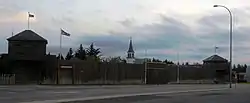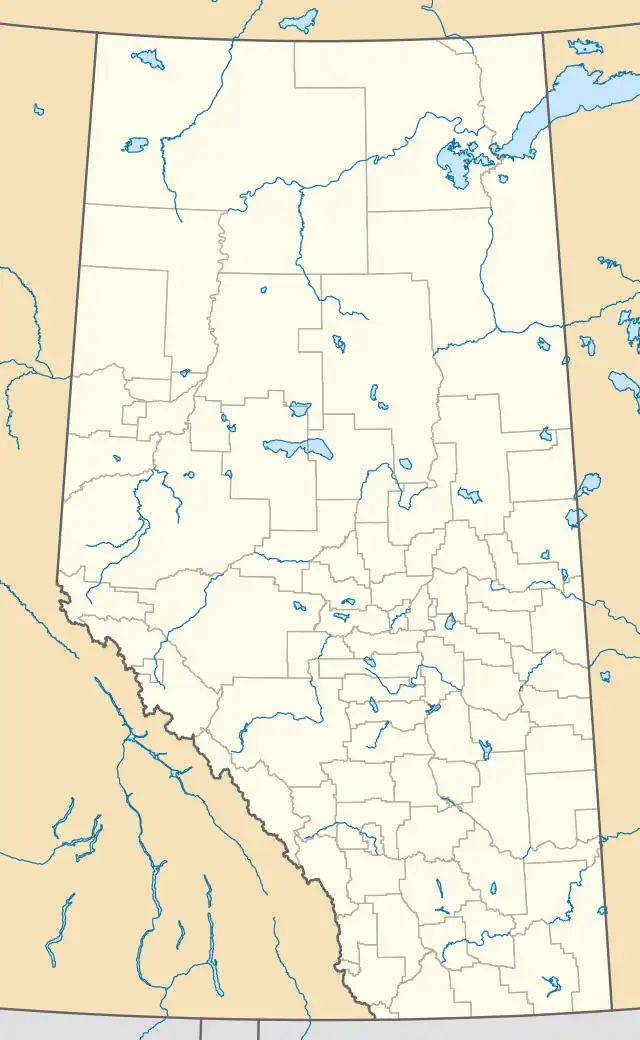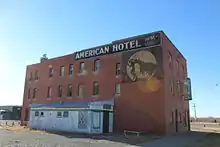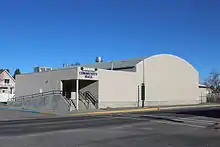Fort Macleod
Fort Macleod (/məˈklaʊd/ mə-KLOWD) is a town in southern Alberta, Canada. It was originally named Macleod to distinguish it from the North-West Mounted Police barracks (Fort Macleod, built 1874) it had grown around. The fort was named in honour of the then Commissioner of the North-West Mounted Police, Colonel James Macleod. Founded as the Municipality of the Town of Macleod in 1892, the name was officially changed to the already commonly used Fort Macleod in 1952.[7]
Fort Macleod
Macleod (1884–1952) | |
|---|---|
Town | |
| Town of Fort Macleod | |
 | |
 Fort Macleod Location of Fort Macleod in Alberta | |
| Coordinates: 49°43′32″N 113°23′51″W | |
| Country | Canada |
| Province | Alberta |
| Region | Southern Alberta |
| Census division | 3 |
| Municipal district | Municipal District of Willow Creek No. 26 |
| Incorporated[2] | |
| • Town | December 31, 1892 (as Macleod) |
| • Name change | April 1, 1952 |
| Government | |
| • Mayor | Brent Feyter |
| • Governing body | Fort Macleod Town Council |
| • Manager | Susan Keenan |
| • MP | John Barlow (Foothills) |
| • MLA | Roger Reid (Livingstone-Macleod) |
| Area (2021)[4] | |
| • Land | 22.54 km2 (8.70 sq mi) |
| Elevation | 945 m (3,100 ft) |
| Population | |
| • Total | 3,297 |
| • Density | 146.2/km2 (379/sq mi) |
| Time zone | UTC−7 (MST) |
| • Summer (DST) | UTC−6 (MDT) |
| Postal code span | |
| Area code | +1-403 |
| Website | Official website |
History

The fort was built as a 70 by 70 metres (230 ft × 230 ft) square on October 18, 1874. The east side held the men's quarters and the west side held those of the Mounties. Buildings such as hospitals, stores and guardrooms were in the south end. Stables and the blacksmith's shop were in the north end.
The town grew on the location of the Fort Macleod North-West Mounted Police (NWMP) Barracks, the second headquarters of the NWMP after Fort Livingstone was abandoned in 1876.[8] Fort Macleod was originally established in 1874 on a peninsula along the Oldman River, then moved in 1884 to the present town location.[9] The Museum of the North-West Mounted Police is located in Fort Macleod.[1]
Once agricultural settlement and the railway came to the region, Macleod boomed. The town became a divisional point for the Canadian Pacific Railway and frontier wood construction began to be replaced by brick and sandstone. In 1906 a fire devastated the downtown and destroyed most of the wooden buildings. From 1906 to 1912 Macleod had its greatest period of growth, as more new brick and stone building replaced the destroyed wooden ones. Then in 1912 the CPR moved the divisional point and 200 jobs to Lethbridge, devastating the local economy. Fort Macleod ceased to grow, and in 1924 was forced to declare bankruptcy. Until the 1970s, the town's economy stagnated and the buildings from the turn-of-the-century remained untouched.[10]
In 1978 Alberta Culture started to inventory the downtown buildings, and in 1982 the downtown became Alberta's first "Provincial Historic Area". As well, Heritage Canada started a Main Street Restoration Project in 1982, aiming to preserve the sandstone and brick buildings, some dating back to 1878.[10][11]
Demographics
In the 2021 Census of Population conducted by Statistics Canada, the Town of Fort Macleod had a population of 3,297 living in 1,342 of its 1,440 total private dwellings, a change of 11.1% from its 2016 population of 2,967. With a land area of 22.54 km2 (8.70 sq mi), it had a population density of 146.3/km2 (378.8/sq mi) in 2021.[4]
In the 2016 Census of Population conducted by Statistics Canada, the Town of Fort Macleod recorded a population of 2,967 living in 1,226 of its 1,426 total private dwellings, a -4.8% change from its 2011 population of 3,117. With a land area of 23.41 km2 (9.04 sq mi), it had a population density of 126.7/km2 (328.3/sq mi) in 2016.[12]
Geography
The town is located in the Municipal District of Willow Creek No. 26, at the intersection of Highway 2 and Highway 3, on the Oldman River. It lies west of the larger community of Lethbridge, near the reserves of the Peigan and Kainai First Nations. It is also located close to the Waterton Lakes National Park.
The town is located 8 kilometres (5.0 mi) north of the McBride Lake Wind Farm, one of the largest wind farms in Alberta. The wind farm has a capacity of 75 megawatts of electricity.
Climate
Fort Macleod experiences a humid continental climate (Köppen climate classification Dfb).
The community enjoys frequent breaks from cold spells in winter when the Chinook wind blows down-slope from the Rocky Mountains. A Chinook on 27 February 1992 caused the temperature to rise to 26.5 °C (80 °F).[13]
The highest temperature ever recorded at Fort Macleod was 102 °F (38.9 °C) on 7 July 1896, 18 July 1910, and 17 July 1919.[14][15][16][lower-alpha 1] The coldest temperature ever recorded was −49 °F (−45.0 °C) on 2 February 1905, 17 December 1924, and 28 January 1929.[17]
| Climate data for Fort Macleod, 1971–2000 normals, extremes 1876–present | |||||||||||||
|---|---|---|---|---|---|---|---|---|---|---|---|---|---|
| Month | Jan | Feb | Mar | Apr | May | Jun | Jul | Aug | Sep | Oct | Nov | Dec | Year |
| Record high °C (°F) | 19.8 (67.6) |
26.5 (79.7) |
27.8 (82.0) |
32.2 (90.0) |
34.5 (94.1) |
38.3 (100.9) |
38.9 (102.0) |
37.2 (99.0) |
36.7 (98.1) |
31.0 (87.8) |
26.1 (79.0) |
25.0 (77.0) |
38.9 (102.0) |
| Average high °C (°F) | −1.3 (29.7) |
1.9 (35.4) |
6.7 (44.1) |
12.7 (54.9) |
18.0 (64.4) |
22.4 (72.3) |
25.6 (78.1) |
24.8 (76.6) |
19.1 (66.4) |
14.3 (57.7) |
4.2 (39.6) |
−0.2 (31.6) |
12.4 (54.3) |
| Daily mean °C (°F) | −7.1 (19.2) |
−4.3 (24.3) |
0.4 (32.7) |
6.0 (42.8) |
11.1 (52.0) |
15.4 (59.7) |
18.0 (64.4) |
17.2 (63.0) |
11.8 (53.2) |
7.2 (45.0) |
−1.2 (29.8) |
−5.8 (21.6) |
5.7 (42.3) |
| Average low °C (°F) | −13 (9) |
−10.4 (13.3) |
−5.9 (21.4) |
−0.8 (30.6) |
4.1 (39.4) |
8.3 (46.9) |
10.4 (50.7) |
9.5 (49.1) |
4.4 (39.9) |
0.0 (32.0) |
−6.7 (19.9) |
−11.5 (11.3) |
−1 (30) |
| Record low °C (°F) | −45 (−49) |
−45 (−49) |
−36.7 (−34.1) |
−23.3 (−9.9) |
−15 (5) |
−10 (14) |
0.0 (32.0) |
−2.2 (28.0) |
−17.8 (0.0) |
−28 (−18) |
−38.9 (−38.0) |
−45 (−49) |
−45 (−49) |
| Average precipitation mm (inches) | 21.0 (0.83) |
17.8 (0.70) |
27.5 (1.08) |
37.7 (1.48) |
57.2 (2.25) |
61.2 (2.41) |
46.5 (1.83) |
50.0 (1.97) |
46.2 (1.82) |
18.9 (0.74) |
20.2 (0.80) |
20.9 (0.82) |
425.0 (16.73) |
| Source: Environment Canada[17][18][19][20] | |||||||||||||
Sports

The town is home to the Fort Macleod Mustangs, Senior AA men's hockey team of the Ranchland Hockey League.[21]
Media
Fort Macleod's local weekly newspaper is the Fort Macleod Gazette.[22]
- Historical newspapers[23]
- Macleod Advertiser — published May 25, 1909, through September 11, 1913
- Macleod Chronicle — in print approximately July 1908 through June 1909
- Macleod Gazette — early issues were entitled The Macleod Gazette and Alberta Stock Record
- Macleod News — ran from November 2, 1916, through to June 1919
- Macleod Spectator — lasted from April 30, 1912, until October 26, 1916
A selection of historical newspapers from Fort Macleod have been digitized from microfilm and are available in the Southern Alberta Newspaper Collection from the University of Lethbridge Library digitized collections. Included are: Macleod Advertiser (1908–1913), Macleod Chronicle (1908–1909), Macleod Gazette (1897–1907), Macleod News (1916–1919), & Macleod Spectator (1912–1916).
Notable people
- Henrietta Muir Edwards (1849–1931), women's rights activist
- Frederick Maurice Watson Harvey (1888–1980), Irish-Canadian soldier and rugby union athlete
- Sir Frederick Haultain (1857–1942), former premier of the North-West Territories
- Joni Mitchell (born 1943), musician
- Ryland Moranz (born 1986), musician
- Constantine Scollen (1841–1902), missionary
- John Wort Hannam (born 1968), musician
Film
The 2005 romantic drama film Brokeback Mountain was filmed in part in Fort Macleod. The laundry apartment is located at 2422 Third Avenue, where a sign is posted marking the "passionate reunion" of Jack and Ennis. Passchendaele was also filmed in Fort Macleod's historic downtown, which acted as a stand-in for Calgary circa 1915. Scenes involving the dust storm and Matthew McConaughey's character were also filmed in Fort Macleod in Christopher Nolan's 2014 film Interstellar, where the giant dust clouds were created on location using large fans to blow cellulose-based synthetic dust through the air.[24] Francesco Lucente's motion picture drama Badland was filmed mostly in Fort Macleod. Francesco Lucente lived in Fort Macleod from 1974 to 1978. His father Salvatore Lucente owned the American and Queens Hotels during that time.
The downtown historic buildings were also used in the 2021 film Ghostbusters: Afterlife.
This site was also used as a filming location for 2023 TV Series The Last of Us.
See also
References
- Museum of the North-West Mounted Police
- "Location and History Profile: Town of Fort Macleod" (PDF). Alberta Municipal Affairs. October 7, 2016. p. 463. Retrieved October 13, 2016.
- "Municipal Officials Search". Alberta Municipal Affairs. May 9, 2019. Retrieved October 1, 2021.
- "Population and dwelling counts: Canada, provinces and territories, and census subdivisions (municipalities)". Statistics Canada. February 9, 2022. Retrieved February 9, 2022.
- "Alberta Private Sewage Systems 2009 Standard of Practice Handbook: Appendix A.3 Alberta Design Data (A.3.A. Alberta Climate Design Data by Town)" (PDF) (PDF). Safety Codes Council. January 2012. pp. 212–215 (PDF pages 226–229). Archived from the original (PDF) on October 16, 2013. Retrieved October 8, 2013.
- "Population and dwelling counts: Canada and population centres". Statistics Canada. February 9, 2022. Retrieved February 13, 2022.
- "Location and History Profile: Town of Fort Macleod". Alberta Municipal Affairs. June 14, 2013. Retrieved June 17, 2013.
April 01, 1952... Name changed to the Town of Fort Macleod
- Historic Fort Livingstone Archived March 12, 2007, at the Wayback Machine
- Fort Macleod history Archived 2006-06-25 at the Wayback Machine
- "Main Street History". Archived from the original on 2006-06-25. Retrieved 2006-06-23.
- Alberta First. Fort Macleod Overview Archived 2010-08-01 at the Wayback Machine
- "Population and dwelling counts, for Canada, provinces and territories, and census subdivisions (municipalities), 2016 and 2011 censuses – 100% data (Alberta)". Statistics Canada. February 8, 2017. Retrieved February 8, 2017.
- Environment Canada—Canadian Climate Data, accessed 2 August 2016
- Environment Canada—Canadian Climate Data, accessed 2 August 2016
- Environment Canada—Canadian Climate Data, accessed 2 August 2016
- Environment Canada—Canadian Climate Data, accessed 2 August 2016
- Environment Canada—Canadian Climate Normals 1971–2000, accessed 3 April 2010
- Environment Canada—Canadian Climate Data, accessed 2 August 2016
- Environment Canada—Canadian Climate Data, accessed 2 August 2016
- Environment Canada—Canadian Climate Data, accessed 23 April 2022
- "RHL – About Us". Ranchland Hockey League. Archived from the original on 2016-03-04. Retrieved 2011-03-09.
- Fort Macleod Gazette
- Strathern, Gloria M. (1988). Alberta Newspapers, 1880-1982: An Historical Directory. University of Alberta Press. pp. 125–126. ISBN 0-88864-137-0.
- Frank McTighe (August 28, 2013). "Hollywood star Matthew McConaughey in Fort Macleod to film scene from 'Interstellar'". Macleod Gazette. Retrieved January 9, 2015.
- Famous Five Foundation biography of Henrietta Muir Edwards
- http://www.usask.ca/history/buffalo/About%20Buffalo.htm Archived 2020-11-11 at the Wayback Machine
- A temperature of 109 °F (42.8 °C) was recorded on 21 July 1877, but this value appears to be incorrect given the elevation of Fort Macleod and the irregularity of observations in that year.




